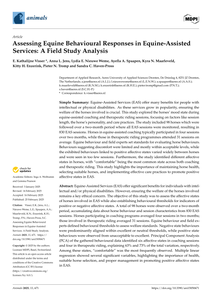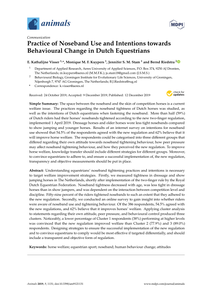The Internet introduces new business choices for customer interaction. In this article we introduce two claims. Firstly, we will show that the way companies shape their customer interaction, and not their sector or size, determine the market segmentation. Secondly, Internet dynamics and its effect on customer interaction rebalances the companies’ marketing and sales function: the Internet shortens the time window for new market opportunities and makes everyone a salesman. Therefore, traditional marketing activities become more and more part of Sales. Corporate communication and branding become more vital.
DOCUMENT

Purpose: Little is known about how tourists’ eating habits change between everyday life and holidays. This study aims to identify market segments based on changes in food consumption and experiences of a sun-and-sea destination’s local food. The authors evaluate to what extent tourists consume local food and assess the contribution of local food experiences to the tourists’ overall experience. Design/methodology/approach: The target population was all tourists visiting the Algarve in the Summer 2018 and included both domestic and international sun-and-sea tourists. A sample of 378 valid questionnaires was collected. Data analysis included descriptive analysis, statistical tests and cluster analysis. Findings: Cluster analysis identified three segments: non-foodies, selective foodies and local gastronomy foodies. Results indicate that tourists change their eating habits during holidays, eating significantly more seafood and fish and less legumes, meat, fast food and cereals and their derivatives. International and domestic sun-and-sea tourists reported that eating local food contributes significantly to their overall tourism experience. Practical implications: Sun-and-sea destinations should promote the offer of local dishes, especially those that include locally produced fish and seafood, to improve the tourist experience, differentiate the destination and increase sustainability. Originality/value: The authors address three identified research gaps: a posteriori segmentation based on tourists’ food consumption behaviour; measurement of changes in eating practices between home and in a sun-and-sea destination; and assessment of the role of food experiences to overall tourism experience of tourists visiting a sun-and-sea destination.
LINK
Purpose: Food waste occurs in every stage of the supply chain, but the value-added lost to waste is the highest when consumers waste food. The purpose of this paper is to understand the food waste behaviour of consumers to support policies for minimising food waste. Design/methodology/approach: Using the theory of planned behaviour (TPB) as a theoretical lens, the authors design a questionnaire that incorporates contextual factors to explain food waste behaviour. The authors test two models: base (four constructs of TPB) and extended (four constructs of TPB plus six contextual factors). The authors build partial least squares structural equation models to test the hypotheses. Findings: The data confirm significant relationships between food waste and contextual factors such as motives, financial attitudes, planning routines, food surplus, social relationships and Ramadan. Research limitations/implications: The data comes from an agriculturally resource-constrained country: Qatar. Practical implications: Food waste originating from various causes means more food should flow through the supply chains to reach consumers’ homes. Contextual factors identified in this work increase the explanatory power of the base model by 75 per cent. Social implications: Changing eating habits during certain periods of the year and food surplus have a strong impact on food waste behaviour. Originality/value: A country is considered to be food secure if it can provide its citizens with stable access to sufficient, safe and nutritious food. The findings and conclusions inform and impact upon the development of food waste and food security policies.
MULTIFILE
Purpose–The purpose of this paper is to describe and understand dimensions of cultural activity involvement and the relationship between cultural activity involvement and behavioural loyalty. Design/methodology/approach–Semi-structured in-depth interviews with 47 customers of a theatre were held. Findings–The study shows that the concept of cultural activity involvement consists of six dimensions: attraction, centrality, self-expression, social bonding, cultural transmission and financial contribution. Three customer segments are taken into consideration according behavioural loyalty levels: incidental spectators, interested participants and the core audience. There are large differences between the three customer segments regarding cultural activity involvement. Research limitations/implications–Introspection might have decreased the reliability. As the study is a case study, problems with external validity are recognised. Practical implications–Given the decline of subsidies in the arts world, it becomes more important to attract more visitors and to increase spending. Performing arts organisations might attract more visitors in case they provide additional services which enable cultural transmission. Moreover, the study shows that certain visitors are willing to contribute additional money to the arts. Originality/value–Current studies about leisure involvement focus on recreation and distinguish four dimensions of involvement. This study focuses on cultural activity involvement and explores these four dimensions, but also shows there are two new dimensions. This study contributes to a further understanding of the relationship between cultural activity involvement and behavioural loyalty.
LINK
Equine-Assisted Services (EAS) offer many benefits for people with intellectual or physical disabilities. As these services grow in popularity, ensuring the welfare of the horses involved is crucial. This study explored the horses’ mood state during equine-assisted coaching and therapeutic riding sessions, focusing on factors like session length, the horse’s personality, and care practices.Keywords: horse–human interaction; welfare; equine-assisted services; health and safety; affective states
DOCUMENT

The space between the noseband and the skin of competition horses is a current welfare issue. The practices regarding the noseband tightness of Dutch horses was studied, as well as the intentions of Dutch equestrians when fastening the noseband. More than half (59%) of Dutch riders had their horses’ nosebands tightened according to the new two-finger regulation, implemented 1 April 2019. Dressage horses and older horses wore less tight nosebands compared to show jumping and younger horses. Results of an internet survey on intentions for noseband use showed that 54.5% of the respondents agreed with the new regulation and 62% believe that it will improve horse welfare. The respondents could be categorised into three different groups that differed regarding their own attitude towards noseband tightening behaviour, how peer pressuremay affect noseband tightening behaviour, and how they perceived the new regulation. To improve horse welfare, knowledge transfer should include different strategies for different groups. Moreover, to convince equestrians to adhere to, and ensure a successful implementation of, the new regulation,transparency and objective measurements should be put in place.
DOCUMENT

Due to a lack of transparency in both algorithm and validation methodology, it is diffcult for researchers and clinicians to select the appropriate tracker for their application. The aim of this work is to transparently present an adjustable physical activity classification algorithm that discriminates between dynamic, standing, and sedentary behavior. By means of easily adjustable parameters, the algorithm performance can be optimized for applications using different target populations and locations for tracker wear. Concerning an elderly target population with a tracker worn on the upper leg, the algorithm is optimized and validated under simulated free-living conditions. The fixed activity protocol (FAP) is performed by 20 participants; the simulated free-living protocol (SFP) involves another 20. Data segmentation window size and amount of physical activity threshold are optimized. The sensor orientation threshold does not vary. The validation of the algorithm is performed on 10 participants who perform the FAP and on 10 participants who perform the SFP. Percentage error (PE) and absolute percentage error (APE) are used to assess the algorithm performance. Standing and sedentary behavior are classified within acceptable limits (+/- 10% error) both under fixed and simulated free-living conditions. Dynamic behavior is within acceptable limits under fixed conditions but has some limitations under simulated free-living conditions. We propose that this approach should be adopted by developers of activity trackers to facilitate the activity tracker selection process for researchers and clinicians. Furthermore, we are convinced that the adjustable algorithm potentially could contribute to the fast realization of new applications.
DOCUMENT

LINK
Due to the environmental and nutritional benefits of insects, their consumption would be one of the solutions to feed the growing human population. Despite the increasing interest in the use of insects as food and feed, consumer acceptance is the major obstacle to successful implementation in Western countries and we studied the factors that influence consumer acceptance in a group of university students from Germany and the Netherlands. In this exploratory research, a survey was conducted (n = 222). Socio‐demographic and psychological factors were established from a theoretical review. In addition, we elaborated on questions regarding information on the health and environmental benefits of consuming insects. Initially, the data obtained are presented through descriptive statistics. The influence of the socio‐demographic and psychological factors, and the information on the willingness to accept insects as animal feed and human food was analyzed using correlations and multiple linear regressions. Results showed more willingness to accept insects as animal feed than in human food. The acceptance among German and Dutch students seems to be driven by issues similar to those in other European countries, such as visual aspects and knowledge about the benefits. The effect of the information on willingness constitutes an important finding of this study, especially for the use of insects in animal feed, since most of the previous studies have focused on the use of insects as human food. Our data support the need to inform and educate consumers about the environmental and health benefits of entomophagy. We conclude that effective efforts to implement entomophagy could increase the level of familiarity with the insect food and inform (or educate) consumers about its benefits. Insights from this study are useful to address studies focusing on specific segments of possible early adopters and consequently addressing communication strategies in this market segmentation.
DOCUMENT

This study aims to help professionals in the field of running and running-related technology (i.e., sports watches and smartphone applications) to address the needs of runners. It investigates the various runner types—in terms of their attitudes, interests, and opinions (AIOs) with regard to running—and studies how they differ in the technology they use. Data used in this study were drawn from the standardized online Eindhoven Running Survey 2016 (ERS2016). In total, 3723 participants completed the questionnaire. Principal component analysis and cluster analysis were used to identify the different running types, and crosstabs obtained insights into the use of technology between different typologies. Based on the AIOs, four distinct runner types were identified: casual individual, social competitive, individual competitive, and devoted runners. Subsequently, we related the types to their use of sports watches and apps. Our results show a difference in the kinds of technology used by different runner types. Differentiation between types of runners can be useful for health professionals, policymakers involved in public health, engineers, and trainers or coaches to adapt their services to specific segments, in order to make use of the full potential of running-related systems to support runners to stay active and injury-free and contribute to a healthy lifestyle.
DOCUMENT
